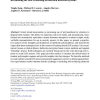29 search results - page 2 / 6 » Learning to Detect and Classify Malicious Executables in the... |
ICECCS
2005
IEEE
13 years 10 months ago
2005
IEEE
The JavaScript language is used to enhance the clientside display of web pages. JavaScript code is downloaded into browsers and executed on-the-fly by an embedded interpreter. Br...
IJNSEC
2008
13 years 4 months ago
2008
In this paper we demonstrate that it is possible in general to detect Windows-based malicious program behavior. Since S. Forrest et al. used the N-grams method to classify system ...
CMS
2010
13 years 5 months ago
2010
While conventional malware detection approaches increasingly fail, modern heuristic strategies often perform dynamically, which is not possible in many applications due to related ...
ML
2010
ACM
13 years 3 months ago
2010
ACM
Current trends demonstrate an increasing use of polymorphism by attackers to disguise their exploits. The ability for malicious code to be easily, and automatically, transformed in...
CVPR
2007
IEEE
14 years 6 months ago
2007
IEEE
The existing methods for offline training of cascade classifiers take a greedy search to optimize individual classifiers in the cascade, leading inefficient overall performance. W...

